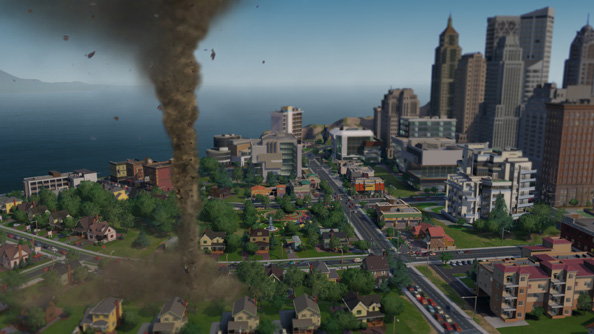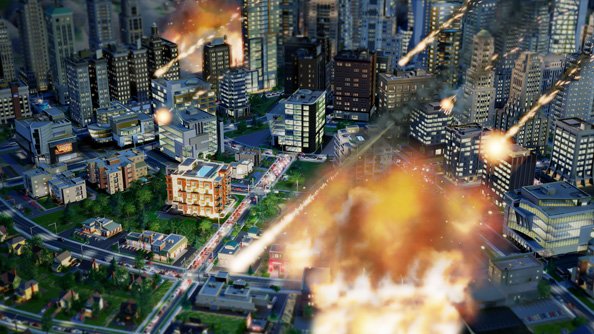SimCity will have the most depressingly accurate homelessness algorithms the series has yet seen. Fail to provide enough employment in your city and your impoverished residential zones will begin spawning dishevelled vagrants who’ll then take up occupancy in your nicest parks. This drags down the desirability of the area, which in turn creates more slums and abandoned quarters, which engenders yet more homelessness. It’s a disastrous circle of societal collapse, but not nearly as exciting as a proper disaster. Sure, poverty is tragic and all, but have you ever seen a tornado? You’d sooner have a homelessness problem than a tornados problem.
Disasters are the most recently revealed feature of Maxis’s city building strategy sandbox thing. Tornados, earthquakes, meteor strikes and UFO attacks can all threaten your carefully constructed utopia, whether they be random chance happenings or simply incurred by the wrath of a vengeful and bored god. Takinga metaphorical magnifying glass to your ant farm societies leaves swathes of your cities either ruined, collapsed, burnt or burning, stretching whatever emergencyservices you’ve bothered to set upto breaking point. Here’s Maxis’s old-timey demonstration of what such disasters might look like under varying degrees of civic care. I’m still not entirely sure what the mayor of the second city in this video isdoing wrong, unless Maxis have some biblical aversion to very tall buildings.There are more disasters to be revealed of course, with the series’ hallmark Godzilla-esque invasions no doubt destined to make a stomping return.
In the rapid-firedemonstration we were given Maxis showed off three cities of a single multiplayer region, all built by one developer. Cities within a region, once connected, will affect one another in a variety of ways. Monte Cristo was designed to be a gambling city, with a dominating, garish strip bordered by slot machine filled obelisks. The commercial appeal of Monte Cristo’s region-famous strip was such that it would draw moneyedresidents from nearby cities. These tourists are all helpfully marked by hovering camera icons in certain viewing modes, allowing you to easily track where your tourism industry is centred and so ensure that resources are spent keeping those locations especially clean and safe.
Every system in SimCity seemingly interlocks with a dozen others. Casinos bring in huge amounts of wealth while simultaneously attracting criminals to area.It’s not simply an invisible aura of criminality either: actual individual criminals will prowl the streets and carry out illegal activities such as burglary. Police presence in an area is also represented by individual police cars who project a radius of civility around them. Should a citizen commit a crime within detection distance of a police unit, they’ll be chased down and arrested. Police stations themselves reduce lawlessness within a local radius, and can be upgraded with garage modules to provide additional police car presence on the streets.In turn, the efficiency of the police patrols will be dictated by the density of traffic on the roads: more crimes will go unpunished if your streets are gridlocked. Traffic density isn’t some notional attribute of a road either, rather it’s the very natural and observableresult of physical, trackable, quantifiable cars making their individual journeys. You can click on any vehicle to see where it’s going and where it’s come from.
Here’s a city being bullied by atornado.

Cities can have one or morepreordainedspecialities. Monte Cristo’s is ‘gambling’ but there are also categories in things like education and electronics. Adopting a speciality in a city will give you a list of goals to reach in that category, shaping your city by nudging you towards constructing the right kinds of infrastructures and key buildings. Industrially specialised towns in a region, such as one that manufactures electronics, will create employment for a nearby town that specialises in housing and recreation. Both will then feed into Monte Cristo’s money-churning roulette-fest once everything’s been connected up appropriately.Highways, waterways, coachesand railway lines connect cities at terminals. Decent placement of these terminals is crucial when trying to attract tourism. In the demonstration, Maxis dropped train stations right next to hotels and amenities, reducing the tourismcommute and increasing the amount of cash pocketed. One of the myriad infographic views displays where foreign dollars are being spent, simplifying placement of interstate connections.
Here’s a city being attacked by rocks fromspace.

Locally, public transport can be micro-managed and fine-tuned. Roads and railcan be traced along the terrain, with elevated portions of track giving the potential for maddening spaghetti junctions and pointlessly rollercoaster-like routes. Road capacity can be increased and upgraded simply by clicking on existing roads too, adding extra lanes and turning dirt paths into bustling motorways. Bridges, when upgraded in this way, can be stylised as suspended wrought iron monumentsor vast concrete ribbons. I countedfour different kinds of bridge in the space of thirty seconds.
Dropping a bus station into your city will allow you to place individual bus stops at street level. Each bus stop has a heat-mapped of effect, similar to that of the police car, which determines how convenient it is for nearby citizens to get to. Typically, and this is something Maxis learned from real city planning guides, a person will walk a maximum of 400 metres to reach a bus stop. I’m not certain what happens otherwise. Perhaps they just flop to the pavement like in that Radiohead video.Again, like the police station, modules can be attached to the bus station to increase the number of bus routes in your city. Fire stations, while we’re talking about modules, can be upgraded in exactly the same way, adding more fire engines to the force.
Here’s a UFO abducting one unfortunate person, which I would argue isn’t strictly within the definition of a disaster.

SimCity has recently shuffled its release date further back. It’s now launching in March 2013, rather than February. The code shown wasn’t without its problems —roads connecting strangely, building destruction (especially during tornado attacks)looking decidedly flat, a moment when a city block inexplicablybecame infested with dozens of police cars— but the powerful underlyingsystems that allow the game to simulate a richly connected and interdependent region of cities are all seeminglyin place. Personally, I won’t misssome of the features whittled away since the previous games (fiddly things likesubwaysand separately drawn waterand electrical grids), and I’m only mildlydisturbed by the always-online-ish requirement, which powers the multiplayer-controlled regions in which your citymust exist.As long as it’s possible to eat around these features, to run your city in a defiant, anti-social, single-playerbubble, then it will be possible to fully enjoy and explore SimCity’s complex systems.
That is to say, I’m not pressing the tornado button if I can’t quickload.
